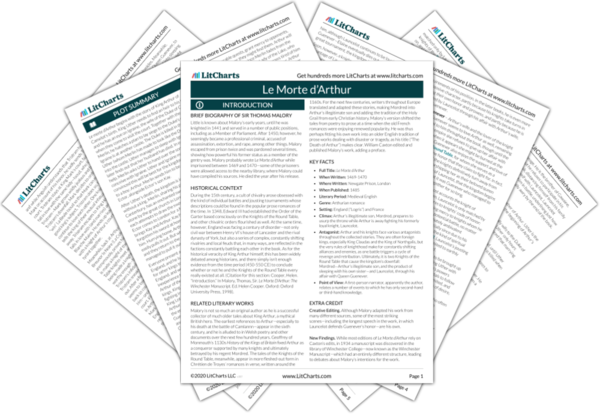Brief Biography of Sir Thomas Malory
Little is known about Malory’s early years, until he was knighted in 1441 and served in a number of public positions, including as a Member of Parliament. After 1450, however, he seemingly became a professional criminal, accused of assassination, extortion, and rape, among other things. Malory escaped from prison twice and was pardoned several times, showing how powerful his former status as a member of the gentry was. Malory probably wrote Le Morte d’Arthur while imprisoned between 1469 and 1470—some of the prisoners were allowed access to the nearby library, where Malory could have compiled his sources. He died the year after his release.
Historical Context of Le Morte d’Arthur
During the 15th century, a cult of chivalry arose obsessed with the kind of individual battles and jousting tournaments whose descriptions could be found in the popular prose romances of the time. In 1348, Edward III had established the Order of the Garter based consciously on the Knights of the Round Table, and other chivalric orders flourished as well. At the same time, however, England was facing a century of disorder—not only civil war between Henry VI’s house of Lancaster and the rival dynasty of York, but also a series of complex, constantly shifting rivalries and local feuds that, in many ways, are reflected in the factions constantly battling each other in the book. As for the historical veracity of King Arthur himself, this has been widely debated among historians, and there simply isn’t enough evidence from the time period (450-550 CE) to conclude whether or not he and the Knights of the Round Table every really existed at all. (Citation for this section: Cooper, Helen. “Introduction.” In Malory, Thomas, Sir. Le Morte D’Arthur: The Winchester Manuscript. Ed. Helen Cooper. Oxford: Oxford University Press, 1998).
Other Books Related to Le Morte d’Arthur
Malory is not so much an original author as he is a successful collector of much older tales about King Arthur, a mythical British hero. The earliest references to Arthur—especially to his death at the battle of Camlannn—appear in the sixth century, and he is alluded to in Welsh poetry and other documents over the next few hundred years. Geoffrey of Monmouth’s 1130s History of the Kings of Britain fixed Arthur as a conqueror supported by many knights and ultimately betrayed by his regent Mordred. The tales of the Knights of the Round Table, meanwhile, appear in more fleshed-out form in Chrétien de Troyes’ romances in verse, written around the 1160s. For the next few centuries, writers throughout Europe translated and adapted these stories, making Mordred into Arthur’s illegitimate son and adding the tradition of the Holy Grail from early Christian history. Malory’s version shifted the tales from poetry to prose at a time when the old French romances were enjoying renewed popularity. He was thus perhaps fitting his own work into an older English tradition of prose works dealing with disaster or tragedy, as his title (“The Death of Arthur”) makes clear. William Caxton edited and published Malory’s work, adding a preface.
Key Facts about Le Morte d’Arthur
-
Full Title: Le Morte d’Arthur
-
When Written: 1469-1470
-
Where Written: Newgate Prison, London
-
When Published: 1485
-
Literary Period: Medieval English
-
Genre: Arthurian romance
-
Setting: England (“Logris”) and France
-
Climax: Arthur’s illegitimate son, Mordred, prepares to usurp the throne while Arthur is away fighting his formerly loyal knight, Launcelot.
-
Antagonist: Arthur and his knights face various antagonists throughout the collected stories. They are often foreign kings, especially King Claudas and the King of Northgalis, but the very rules of knighthood make for constantly shifting alliances and enemies, as one battle triggers a cycle of revenge and retribution. Ultimately, it is two Knights of the Round Table that cause the kingdom’s downfall: Mordred—Arthur’s illegitimate son, and the product of sleeping with his own sister—and Launcelot, through his affair with Queen Guenever.
-
Point of View: A first-person narrator, apparently the author, relates a number of events to which he has only second-hand or third-hand knowledge.
Extra Credit for Le Morte d’Arthur
